There are few things that make dogs (and their veterinarians) tear their hair out like skin allergies. Skin conditions are the top cause for veterinary visits in the United States, and most of those skin problems are symptoms of allergies. Signs of allergies in dogs include itching – called pruritus – redness, hair loss, and damaged and infected skin. Vomiting, diarrhea, and weight loss are other but less common effects and are generally associated with food allergies in dogs.
WHAT CAUSES ALLERGIES IN DOGS
In the simplest terms, allergy is the result of an immune system gone awry. When it’s functioning as it should, immune system agents patrol the body, checking the identification (as it were) of every molecule in the body. The immune-system patrollers allow the body’s own molecules and harmless foreign substances to go about their business, but when they are operating properly, they detect, recognize, and attack potentially harmful agents such as viruses and pathogenic bacteria.
When a dog develops an allergy, the immune system becomes hypersensitive and malfunctions. It may mistake benign agents (such as pollen or nutritious food) for harmful ones and sound the alarm, calling in all the body’s defenses in a misguided, one-sided battle that ultimately harms the body’s tissues or disrupts the body’s usual tasks. Or the immune system may fail to recognize normal agents of the body itself and start a biochemical war against those agents (an “autoimmune” response).
Allergies can be very frustrating to diagnose, manage, and treat. Just as in humans, allergies are usually a lifelong condition without a cure. Management is focused on identifying the causative allergen(s) (often through extensive testing), eliminating the allergen(s) from the dog’s environment when possible – or, if not possible, reducing the dog’s exposure to the allergen(s) as much as possible, and treating secondary effects of allergies, such as infections and discomfort.
In theory, this is very simple; in reality, it can be difficult and frustrating. Any breakthrough in controlling the dog’s exposure to the allergens (assuming they even can be determined!) can lead to itching and infections. Whenever I am counseling an owner on managing a dog’s allergies, I start with the caveat that we will never cure the allergy. We will only keep it under control.
I wish that more dog owners were aware of their preferred breeds’ genetic predisposition to allergy and planned accordingly when buying or adopting.
Breeds to consider as particularly prone to allergies include West Highland White Terriers, Golden Retrievers, Boxers, Shar-Peis, Lhasa Apsos, Shih-Tzus, Boston Terriers, Staffordshire Terriers, and Bulldogs. There are many others as well, so thoroughly research any breed that you are interested in owning. If possible, ask about the parents and other offspring that have resulted from the same matings; if the parents or siblings have severe allergies, chances are better than even that the puppies will develop them, too.
SIGNS OF ALLERGIES IN DOGS
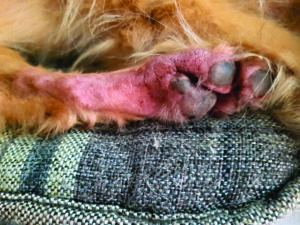
Photo Credit: Raquelsfranca/
Dreamstime.com
So how do you know if your dog has allergies? Allergies generally manifest as dermatitis – meaning skin inflammation. In particular, skin infections are called pyoderma, meaning “pus skin.” A one-time skin infection that responds to treatment is not a reason to suspect allergies. That can happen to any dog! It is when infections recur again and again that makes allergies the prime suspect as the underlying cause.
Allergies and pyoderma are a vicious cycle. When a dog is exposed to whatever substance(s) to which he is allergic (whether it be fleas, food, or an environmental allergen like dust mites), his first and most intense symptom will be itchy skin. (In contrast, the most common symptoms of allergy in humans are sneezing and an itchy, runny nose and eyes.) As a result, the allergic dog will scratch and chew at his skin, damaging the skin’s protective barrier.
Once the skin is broken, opportunistic bacteria, particularly Staphylococcus (which commonly lives harmlessly on the skin in some amount), enter the damaged area and colonize it. This stimulates the immune system to release white blood cells to fight off the invaders. The white blood cells release inflammatory substances to kill the bacteria – but they also irritate the surrounding tissue and cause more pruritus. The itching continues, the dog continues to scratch, and more bacteria enter the broken skin. The cycle continues.
Intense itching and discomfort, redness, and skin infections that recur despite appropriate treatment are the hallmarks of allergies. In the case of severe allergies, it may be hard to distract a dog from the maddening itch.
Recurrent ear infections can also be associated with allergies. Or your allergic dog may scratch behind his ears, along his belly, or chew on his feet. The skin is often moist and red and may have a yeast-like odor. Epidermal collarettes – small, flaky circles – may be seen; these are most often noted on the belly, where there is less hair.
DIAGNOSING ALLERGIES IN DOGS
When you take your dog into the veterinarian for itching and red skin, an initial skin work-up will be done. This includes three important steps: a skin scrape, tape cytology, and skin impression. This will determine if there is an easily treatable cause for the discomfort and if pyoderma is present. Mite infections can lead to these symptoms and are easy to treat.
For a skin smear, a glass slide is pressed against the infected area, dried, stained, and examined under a microscope.
A skin tape cytology is similar. A piece of acetate tape is pressed to a place on the dog’s skin in an infected area or where a pustule is seen; then the tape is removed and examined microscopically. The veterinarian is looking for the presence of mites, yeast, or bacteria to determine the cause and treatment for the infection.
If mites are not suspected to be the cause and none are found on the scrape, the veterinarian will treat the infection based on the skin cytology and impression.
If bacteria are found, a topical shampoo with antibacterial effects may be used. Chlorhexidine shampoos are inexpensive and readily available in most veterinary clinics. Alternatively, if the infection is widespread and/or severe, an oral antibiotic like a cephalosporin may be more appropriate.
If yeast is also present, a topical shampoo or mousse treatment with an antifungal agent will be needed. In some cases, oral antifungals such as itraconazole are also used.
A one-time skin infection does not indicate allergies, but when infections recur – especially in susceptible breeds – allergies are the most likely diagnosis. At that point, it becomes necessary to try to identify what substances the dog is allergic to.
We’ll discuss food and substances that are inhaled or that come into contact with the skin (such as dust mites, pollen, grass, mold, and other common environmental substances) that commonly cause canine allergies in upcoming issues. Below, we’ll discuss the most common canine allergy: Flea allergy.
DON’T BE IN “FLEANIAL” – SIGNS YOUR DOG MIGHT HAVE FLEAS
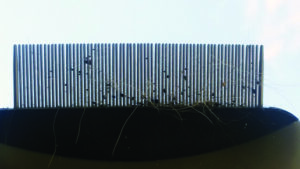
As vexing as they may be, fleas are the simplest cause of canine allergy to diagnose and treat. The offending agent is the flea’s saliva: When they bite into a dog, they inject a small amount of saliva into the dog’s skin, and the dog’s immune system responds to this material.
Flea allergy typically develops when a dog is between the ages of 2 and 5 years, though dogs who are as young as 1 year or are senior dogs can also develop flea allergies.
Some dogs are so intensely allergic to flea saliva that one flea bite can lead to widespread, severe itching and self-trauma, setting up the pyoderma cycle. (These dogs in particular need to be kept on flea prevention year round in most parts of the United States. Fleas can be a year long problem in many parts of the United States that stay warm or have warm days during the winter.)
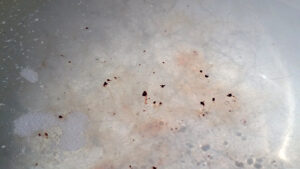
Generally, diagnosing flea allergy is fairly simple. It presents with symptoms in the “flea triangle”– the base of the tail, rear legs, and inner thighs. There is hair loss in those areas, where fleas tend to congregate. Sometimes, live fleas can be seen crawling around in those areas, but not always.
Your veterinarian may use a fine-toothed comb (called a flea comb) to detect and expose living fleas. Whether or not fleas are found with a comb, she will also conduct a skin scrape, tape, and cytology as outlined above to determine what infectious agents may be present. The pruritus caused by fleas leads to the vicious cycle of skin trauma and pyoderma, so that must be treated in conjunction with eliminating fleas.
It’s important to remember that just because you don’t see fleas doesn’t mean that they are not present. Fleas remain on a dog for only a few minutes to an hour while they are feeding. Once they feed, they return to their environment. By the time you begin seeing live fleas crawling on your dog, the infestation is severe. It is common for owners to be certain that their dog cannot have fleas, just for us to use a comb and find several live ones. (We veterinarians call this “fleanial.”)
TREATMENT FOR FLEAS IN DOGS
Flea treatment obviously involves killing the fleas. (See “Quick, Make Fleas Flee.“)
In addition to recommending products that kill the fleas, your vet may also prescribe a medication to help with the itching. Older medications like oral steroids are very effective but do come with significant side effects such as increased drinking, urinating, panting, restlessness, and the risk of inducing diabetes with long-term use. Some dogs also experience temporary behavioral changes. Steroids are very inexpensive, and generics are available.
Newer medications such as Apoquel (oral tablet) and Cytopoint (injectable) specifically target the factors that cause itching, are safer, and are extremely effective without the side effects of steroids. They are also more costly, as no generics are yet available.
But the pyoderma caused by self-trauma must also be treated. This is called flea allergy dermatitis (FAD). Treatment involves either topical shampoos or mousses and/or oral medications, depending on what the veterinarian finds on microscopic examination.
FLEAS ARE THE EASIEST CANINE ALLERGY TO TREAT
If your dog has flea allergies, consider yourself (somewhat) lucky! Of the three main causes of allergies in dogs, flea allergy is the easiest to treat and manage. With careful attention to preventives, maintaining a flea-free house and yard through regular treatments, dogs with FAD can live a happy and itch-free existence.


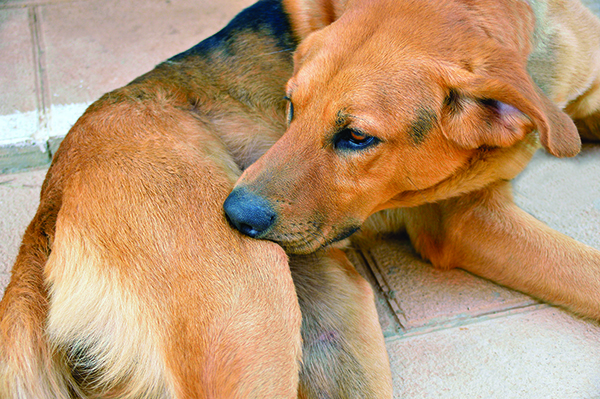


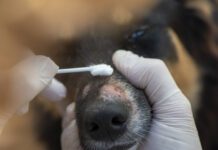

My dog . 6 years old. Is very sad and bored. It is raining outside. I play ball. In the house. Still bored. Help. Judithnewell1246@gmail,com. 716 901 6285. Call me is better. Please help.
Many things you can try to help. If you feed him Kibble, then dont use a food bowl but instead hide his food ration around the house and he will spend a long time looking for his food. Teach him a new trick or a new command like touch your hand or some other game. If he has not got a kong toy then maybe get him one and stuff it with treats or have a look on line for a book called ‘Brain Games for Dogs’ lots of ideas in the book. Good luck and hope this helps
I’ve subscribed to WDJ for decades and given many subscriptions to friends & family. What I most appreciate about WDJ is its independence from advertisers or other economic interests. This gives me confidence and trust in it as a valued resource for my beloved dogs’ care. I cannot always get conflict-free advice from other canine health professionals. I am disappointed in this allergy article because I don’t see a discussion of dog food—specifically kibble—and the impact that its extrusion processing, additives/preservatives, and its basic ingredients have on a dog’s immune system. This is a self-regulated industry that is forced to recall its products far too often after sickening & killing animals with their products. I am just an ordinary consumer, & yet I feel I must do my own extensive research to get the info I need to protect my dogs from products that advertise as safe & nutritious. I have switched to homemade food for a time & now fresh dog food to ensure I’m not feeding things to my dogs that could harm them. I supplement with raw meaty bones & the occasional raw organ meats. In my experience, holistic vets understand and convey the importance of nutrition as the building block of canine health & longevity. I hope and pray that more people will catch on & stop feeding their dogs commercially manufactured “food.” If they will educate themselves with sources in addition to traditional vets (many with economic ties to the pet food industry), question conventional ways of thinking about dog food, and take the long view that spending more now to healthfully feed their dogs will not only save money in the long run in vet bills, but will also save their pets & themselves the pain/discomfort/angst of the inevitable illness & disease (allergies, cancer, organ failure, diabetes, etc.) caused by poor/unsafe nutrition. It will also make their dogs’ skin & fur healthy, give them more energy to play, and extend their lives—something worth more than money. WDJ: please write more in-depth articles about nutrition, alternatives to traditional kibble, the possible impact on dogs’ health of poor food sold as nutritious, and the benefits of feeding good, whole, unprocessed food instead. I think our dogs are worth it.
I agree! My dog has severe allergies with the vicious cycle of itching, licking, raw skin, then infection. I use the shampoo and the mousse on him. The other alternatives we’ve tried are apoquel (which increases tumor growth) and cyto point injections which were completely ineffective. He’s been on several trials of antibiotics which have dire effects on his gut health. At this point, he lives in an e-collar which breaks my heart.
I’ve researched nutrition in dogs and I wish I could get rid of kibble. The problem is that anything that’s remotely healthy for dogs is astronomically expensive and completely out of my reach (My dog is 75 pounds and I have two of them). I’d love to know more about homemade dog food but I don’t know how to make it nutritionally balanced. I’d love to know of any recipes that I could follow that are economical and healthy. I know without a doubt it would improve my dog’s health.
I cook for my dogs once a week; leave a few days worth in the fridge and freeze the rest for the week. I use a website called Balance It. You buy the supplement and then they have a recipe creator so you can literally feed 1000’s of different combinations. It is definitely more expensive than kibble, but cheaper than canned or commercial raw dog food. The combined weight of my dogs is 170 lbs. If you pick cheaper foods to feed or buy only what is on sale at the supermarket, you can bring the cost down. I would suggest checking out the website and playing around with a few recipes to get an idea of what it would cost.
You CAN get rid if the dried dog foods. Easy peasy. Make up your own, fresh.
I feed raw kangaroo meat (donkey when that was noravailable) but you can buy fresh mean from pet supply shops,
The you add the rest, I use 2/3 cereals (whole oats of brown rice) to 1/3 pulse (dried peas/lentils /beans), boiled to porridge like consistence . Then add supplements. At the moment is add olive oil, gelatine, brewers yeast the stuff for horses from the produce store), and a multi-vit supplement. I know exactly what goes into their food.
They also each get a piece of raw kangaroo tail a day.
Other bones you can buy for the butcher — neck bones and tail bones are the best. I have in the past (when Kangaroo was not available) fed lamb necks and pigs trotters. Chicken necks I pass on. — to soft and too fatty.
You can add whatever other vegetables of fruit available. I used to juice veggies but found they weren’t necessary. Basically mine get fresh parsley and whatever else is available for my human meal preparations.
If food allergies, NO OATS and RICE, or peas, or potatoes or sweet potatoes… grains/ CARBS are so highly inflammatory. Brewers Yeast is often another common trigger of food allergic dogs. Check out Dr. Karen Becker or Keep the Tail Wagging, on YouTube,
Try MyPetCarnivore or PawfectlyRawNewEnglad for affordable raw food. If you can at least use it for a few meals a week, it may help! Try Dr. Karen Becker on YouTube for invaluable videos on canine allergies. My yellow lab suffered so badly I thought I was going to have to “lift him up” to get him out of his misery. I’ve known personally 2 different dogs who had to be “lifted up” because the vicious cycle of antibiotics, topicals, apoquels, cytopoint, etc. that eventually stopped working and caused such havoc on the dog’s system that the dogs couldn’t live a decent quality of life. PLEASE try Dr. Becker’s videos. Soothe areas with frozen damp tea towels soaked in green tea and ACV,i also clean ears regularly with same. Try a home air purifier to rid the air of allergens, wash bedding and floors often with a natural cleaners (no chemicals!), vacuum daily. Do a foot bath for paws before coming in the house (use a squirt bottle with water and acv to get between toes.) Important also is to do a liver and kidney detox (SustenanceHerbs has a great organic one) to rid body of toxins. That will help relieve some of the body’s burden. Check out AnimalEO also for essential oils that have had amazing results. Possibly most difficult when you’re seeing them suffer, remain happy and positive around your pup!!! If you are always sad around them, they’ll begin to feel they’ve disappointed you. So yes, this all can be time consuming and expensive but I firmly believe that when we accept the responsibility of caring for a dog, that means we have to do our best physically, emotionally and financially by them. Skip a few coffees and meals out, call utility companies to see what bills can be reduced, ask for gift cards to get food and supplements for the pups for your birthdays/holidays.. a healthy pup is the BEST GIFT!
You should check out perfectlyrawsome.com. I had a certified canine nutritionist from that site formulate two balanced custom recipes for my dog that would fit my budget. SO worth it!! The Facebook group called “Raw Feeding University — RFU” is run by the same nutritionist. They are SO helpful.
A wonderful comment Jaye Schissel! Thank you. I agree with, and second, every single word you wrote. WDJ please catch onto this now quite prevalent thinking amongst dog owners about most commercial dog foods and treats. The actual harm many of these products can do when fed to dogs long term, and the often completely misleading marketing claims made by the companies which produce them.
May I suggest a treat ball. You fill with small treats then give it to the dog. The dog will have fun pushing it around and as a reward a treat is produced. I put in dry dry kibble. It seems to dispense better than lets say Cheerios. Wash the inside from time to time so crumbs don’t become rancid. Wash outside to remove the saliva.
Go to Chewy.com and checkout ‘Omega Paw Tricky Treat Ball Dog Toy’
I agree with the above highlighting the potential of the food allergy connection as well as the outside enironment. I do appreciate WDJ emphasizing the importance of understanding and researching genetic predispositions towards allergies in certain breeds. I might add the poodle breed to the list. If you adopt a dog or spend megabucks for a hybrid, such as the latest fad of poodles mixed with “pick your breed”, or just purchasing from a irresponsible backyard breeder you’re treading into the waters of breeding for profit, whereby anything alse that affects the bottom line such as genetic testing, temperament, hips, thyroid checks, patellas etc. goes by the wayside. You won’t know about the health of the parents. Adopting a dog from a shelter will give you no information regarding health (which includes allergies) about the parents of what you are buying. Buying from a responsible/preservation breeder offers you the best chance to obtain a healthy dog. If a responsible breeder that does genetic testing, structural testing, thyroid, heart etc. temperament testing and sees that allergies are starting to pop up, those dogs will be out of the breeding program. If you feel like you need to “save” a shelter dog, well that is laudible, but be ready for a life time of potential problems from temperament and/or health, and the same goes for “for profit” designer dogs or untested purebreds from backyard breeders.
my dog does not have allergies to food, though I do not give her chicken, but environmental ones, and they I believe stem from too many vaccinations from vets. She has never been the same after 4 in one shots included in distemper etc. I changed vet but the effect is there. Shame on vets who over do and charge too much for titer tests. I have spent way more than I should have due to this, And my dog is a wonderful dog, Hope, A great labradane.
We tend to NOT have leas here (north East East Coast , Australia), We have Paralysis ticks, so the dogs are permanently of tick proof stuff, that eliminates the fleas as well.
It is pointed out in the article that future issues will address food and other allergen inducing exposures, anxious to see them! And I agree with the treat ball to keep your pup from being bored, I have an Australian Shepherd who brings me the treat ball several times a day. Be careful not to over feed — usually his breakfast and dinner are what make up the treat ball kibble. I would love to do fresh food for my baby, but haven’t figured out how to incorporate fresh with the treat ball — he would be crushed without it he loves it so much. Besides keeping him from being bored, it keeps him slim and engaged — always working his mind and stimulation.
Try using bits of (nitrite free) beef or turkey jerky that has no sugar in the ingredients. Frozen bits of watermelon or strawberries. Plain, unsweetened frozen yogurt balls?